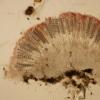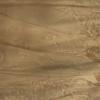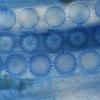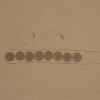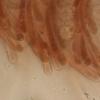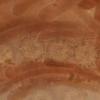
21-12-2025 09:32
Hello.A tiny ascomycete found embedded in wood in

21-12-2025 21:32
Pol DebaenstHello, Garden, Burgweg 19, Veurne, BelgiumOn 10/1

22-12-2025 23:38
Patrice TANCHAUDBonsoir, récolte sur un mur en pierre, apothéci

22-12-2025 00:47
Patrice TANCHAUDBonsoir, récolte à proximité du milieu dunaire

21-12-2025 21:40
Isabelle CharissouBonjour, j'aimerais connaitre les références de

20-12-2025 23:08
Patrice TANCHAUDBonsoir, récolte sur sol sablonneux dans l'arri�
Boudiera
Zuzana Sochorová (Egertová),
13-10-2020 20:40
 Hello,
Hello,this Boudiera has been collected in South Bohemia, in a meadow with a lot of Hygrocybe species. One group of Boudiera was intermixed with Ramsbottomia macracantha.
Apothecia only to 2.5 mm, pulvinate, purple, sessile.
Ascospores without ornament 21.9-24.6 micrometers (average 23.1 micrometers), spines (2.8)3.1-4.4(4.7) micrometers, at base mostly 0.5-1.6 micrometers, inside asci having a gelatinous sheath. However, in some asci ascospores with much wider spines occur, up to 3 micrometers wide at base.
Asci operculate, arising from simple septa, about 390 micrometers long, 38-42 micrometers broad, 8-spored.
Paraphyses 4.2-7.2 micrometers wide, septate, simple, containing purple pigment, apex enlarged, 10.3-12.9 micrometers.
Medulla t. intricata, up to 230 micrometers thick. Ectal excipulum 70-110 micrometers thick, t. angularis-globulosa.
I would determine it as B. tracheia. Do you agree? Have you also observed such a variable ornament in Boudiera?
Thank you, Zuzana
Lothar Krieglsteiner,
13-10-2020 20:44

Re : Boudiera
Hello Zuzana,
if you did not observe free spores (I suggest this because you don`t show them), you cannot conclude how the ripe ornament can be. I remember for instance B. areolata as having very similar spores than yours when unripe, and it becomes ripe quite late.
The common growth with Ramsbottomia shows me that you collected on strongly acid soil. So B. areolata could be a possibility.
But - you should wait until you find enough ripe spores outside the ascus - or look again in your sample in older ascomata.
P.S. Sorry - I did not see your second contribution with free spores. So -... no opinion.
But: yes, I remember very big variation betwenn unripe and fully ripe spore ornaments.
if you did not observe free spores (I suggest this because you don`t show them), you cannot conclude how the ripe ornament can be. I remember for instance B. areolata as having very similar spores than yours when unripe, and it becomes ripe quite late.
The common growth with Ramsbottomia shows me that you collected on strongly acid soil. So B. areolata could be a possibility.
But - you should wait until you find enough ripe spores outside the ascus - or look again in your sample in older ascomata.
P.S. Sorry - I did not see your second contribution with free spores. So -... no opinion.
But: yes, I remember very big variation betwenn unripe and fully ripe spore ornaments.
Zuzana Sochorová (Egertová),
13-10-2020 21:20

Re : Boudiera
Hello Lothar,
in the beginning I really had no free spores, but I let the fungi in a fridge for several days and obtained them. The measurements I give are made on free spores.
I know B. areolata, have collected a rich population in a former kaolin quarry in Moravia.
I have a possibility to sequence the find, but it probably woudn't help, because only minority of the species are in GenBank. Also, there are two specimens of B. dennisii and one of B. tracheia, but this B. tracheia is 100% identical with one of those B. denisii and only 96.77% with the second one. Identity between the two specimens of B.denisii is 96.91% (therefore, at least one collection must be identified wrongly).
Z.
in the beginning I really had no free spores, but I let the fungi in a fridge for several days and obtained them. The measurements I give are made on free spores.
I know B. areolata, have collected a rich population in a former kaolin quarry in Moravia.
I have a possibility to sequence the find, but it probably woudn't help, because only minority of the species are in GenBank. Also, there are two specimens of B. dennisii and one of B. tracheia, but this B. tracheia is 100% identical with one of those B. denisii and only 96.77% with the second one. Identity between the two specimens of B.denisii is 96.91% (therefore, at least one collection must be identified wrongly).
Z.
Lothar Krieglsteiner,
14-10-2020 08:10

Re : Boudiera
Hello Zuzana,
thanks for the information. I only found areolata and acanthospora (on limestone), so I cannot contribute something to your fungus.
Marvellous find(s)!
Yours, Lothar
thanks for the information. I only found areolata and acanthospora (on limestone), so I cannot contribute something to your fungus.
Marvellous find(s)!
Yours, Lothar



